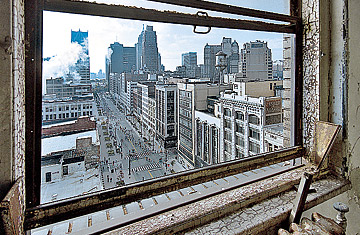
View of downtown Detroit through a window of the Broderick Tower on Woodward Avenue, 2005.
(5 of 5)
For its part, Detroit must address the fact that a 138-sq.-mi. city that once accommodated 1.85 million people is way too large for the 912,000 who remain. The fire, police and sanitation departments couldn't efficiently service the yawning stretches of barely inhabited areas even if the city could afford to maintain those operations at their former size. Detroit has to shrink its footprint, even if it means condemning decent houses in the gap-toothed areas and moving their occupants to compact neighborhoods where they might find a modicum of security and service. Build greenbelts, which are a lot cheaper to maintain than untraveled streets. Encourage urban farming. Let the barren areas revert to nature.
Most crucially, the entire region has to realize that defining itself solely by the misperceived needs of a single industry has left all of southeastern Michigan dazed and bleeding. And yet the conditions for resetting that economic model couldn't be more favorable. The collapse of the UAW's prohibitive wage scale, coupled with the vast unemployment, is turning what was once the nation's most expensive labor market into one of the cheapest. For the first time since Henry Ford offered $5 a day to the men who assembled the Model T back in 1914, Detroit is open to new industry.
America isn't so keen on national industrial policy. But in Detroit's past, you can find an idea for its future--and the nation's. Back in the '50s, the Federal Government began investing what would eventually reach half a trillion dollars in what became the interstate highway system. You could have considered that an incredible subsidy for the auto industry--which it was--but it was also an investment in the nation's future.
It's an adaptable model. The fuel-cell technology that dazzled me at the GM Tech Center is less about autos than it is about energy--energy, as hydrogen, that exists in every molecule of water. What's to stop us now from turning Detroit--its highly trained engineering talent, its skilled and unskilled workforce desperate for employment, its underutilized production facilities--into the Arsenal of the Renewable Energy Future?
If we did, Detroit could go back to building something America needs. As a nation, we could prove that we can still make things. And while we're at it, we could regenerate not just a city but our sense of who we are.
ASSIGNMENT DETROIT WWW.TIME.COM/DETROIT A SPECIAL TIME INC. PROJECT
A Year in Detroit, Day by Day
For daily coverage of the issues and challenges facing this once great American city, go to time.com/detroit
